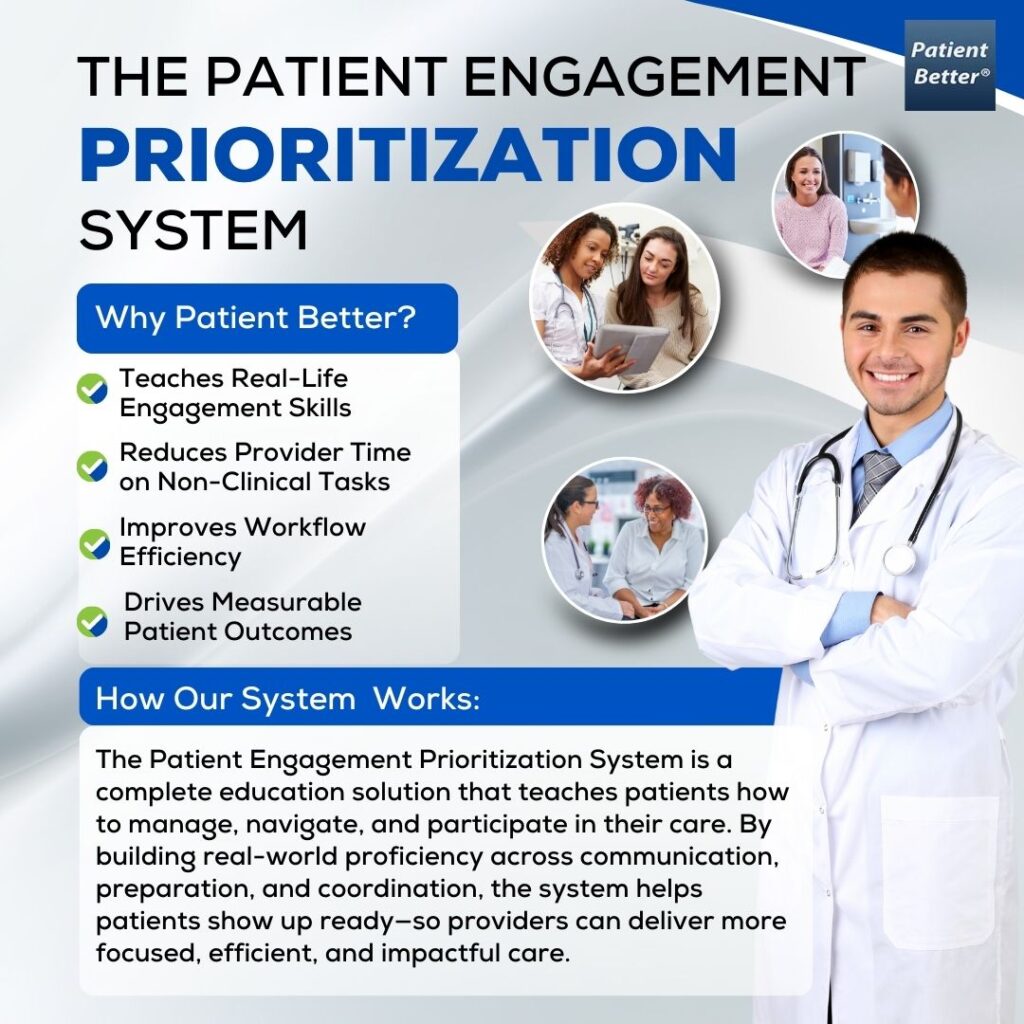A Trusted Patient Engagement Solution is More Than Just Giving Instructions—It’s a Learned Skill. And We Teach It.
Looking to Enhance Patient Engagement? We Have the Solution.
One of the biggest challenges in healthcare today is ensuring that patients take an active role in their care. Gaps in engagement—such as missed appointments, incomplete paperwork, and poor medication management—can lead to inefficiencies and impact patient outcomes.
The Solution: The Patient Engagement Prioritization System (PEPS) provides a structured, easy-to-implement approach that helps patients stay informed, organized, and proactive in their healthcare journey. By integrating PEPS into your practice, you’ll experience smoother workflows, improved patient adherence, and better overall outcomes—without adding extra strain to your team.
The Problem: When Patient Engagement Lacks Meaning and Structure
For too long, patient engagement has been measured using outdated tools built on surveys, assumptions, and rote learning. These methods may track awareness or surface-level behaviors, but they don’t develop or evaluate the real skills patients need to navigate today’s healthcare environment.
Traditional patient education is also fragmented—condition management is delivered in the exam room, health habits are left to self-research, and system navigation is largely ignored. Even when information is provided, patients are rarely taught how to think critically, communicate effectively, or apply what they’ve learned in real-world situations.
That’s why Patient Better exists.
We measure what truly matters: capability. Our system uses applied, Meaningful Learning to assess and build each patient’s healthcare proficiency—meeting them where they are and guiding them toward confident, independent care participation. This is not passive education. It’s a full-spectrum system that prepares patients for real-life healthcare decision-making.

Our Solution: The Patient Engagement Prioritization System
Every healthcare professional wants better patient outcomes—but not at the expense of increased workload.:
✅ Reduce unreimbursable activities by eliminating repetitive explanations and inefficiencies.
✅ Streamline documentation with patients who provide accurate, structured information upfront.
✅ Deliver more in-depth, data-driven care without adding extra administrative burdens.
✅ Enhance your reputation as a provider who meets today’s patient education needs.
✅ Improve patient compliance and outcomes through a structured, self-guided system.
Why Patient Better Works: A System Rooted in Applied Learning Science
Patient Better is built on the principle that meaningful patient engagement is not instinctual—it must be taught, measured, and developed over time. While traditional education approaches rely on passive instruction and rote memorization, our system applies evidence-based learning strategies to deliver a more lasting and effective impact.
Through structured, real-world education, patients build healthcare proficiency across communication, preparation, and navigation. This promotes stronger decision-making, improved adherence, and more productive clinical encounters.
Our comprehensive approach ensures that patients don’t just understand information—they know how to use it. And when patients are capable and confident, providers gain time, efficiency, and better outcomes.
Think Your Patients Won't Engage? Think Again.
Many healthcare professionals believe their patients won’t take the initiative to engage actively in their healthcare. However, with Patient Better’s ‘Patient Engagement Prioritization System,’ we’ve seen transformative results. By providing clear education, tools, and incentives, patients are more likely to participate and take responsibility for their health. This system is designed to make it easy and rewarding for patients to engage, leading to better health outcomes and less strain on providers.
Manage a patient’s care for them, and the burden stays with you. Teach them to participate in their care, and they’ll thank you for giving them the confidence to take control—so you can focus on delivering high-quality care, building trust, and improving outcomes.
Jennifer Woodruff, MHA – Founder of Patient Better
Book a No-Obligation Discovery Demo Today
Discover how Patient Better can transform your practice and improve patient outcomes in just 20 minutes. Our Discovery Demo offers a personalized walkthrough of our comprehensive education program, showcasing how it can integrate seamlessly into your current workflow.
What to Expect:
- Overview of Patient Better: Learn about our navigation and administration education services.
- Live Demonstration: See our platform in action and how it benefits your practice.
- Q&A Session: Get answers to all your questions from our expert team.
Ready to enhance your practice with Patient Better? Book your free 20-minute Discovery Demo today and take the first step towards more efficient and effective patient care.
Disclaimer: This education was brought to you today by The Patient Better Project Inc., a 501(c)(3) organization dedicated to reshaping the way patients and caregivers navigate care. We are committed to empowering individuals with the knowledge and tools necessary to take control of their health journeys, ensuring that everyone can access the care they need with confidence and clarity.
The information provided here is for educational and entertainment purposes only. It is not intended as, nor should it be considered a substitute for professional medical advice, diagnosis, or treatment. Always seek the advice of your physician or other qualified health provider with any questions you may have regarding a medical condition. If you think you may have a medical emergency, immediately call 911 or your local emergency number.

